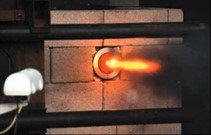Keeping aircraft in the sky: Combustor burn-through testing


In aircraft jet engines, combustors produce hot gas at up to 40
bar and 1650°C or more.
Although unlikely, hot gases could burn through the combustor
body, damaging the engine mounting or airframe. In that event,
emergency systems quickly shut down the engine, but critical
components must survive until that has happened. Aircraft
manufacturers show that their protection works by testing under
burn-through conditions.
How did HSE help?
HSE's Science and Research Centre has done this testing in the
past, but when Mitsubishi Aircraft Corporation (MITAC) approached
us, our facility had been unused for several years. Having looked
around the world without finding a suitable alternative, MITAC
asked us to recommission our test rig.
Our rig burns jet fuel with compressed air in a modified jet
engine 'can combustor'. A nozzle funnels the hot, high-pressure
gases into a 25 mm diameter, supersonic 'torch' directed at the
test sample.
Recommissioning involved refurbishment, replacement or
recertification of almost every component.
We carried out two tests, one observed by JCAB, the Japanese
aviation authority. Each test lasted three minutes. The test
sample, a flat plate, was instrumented for pressure and temperature
with both point measurements and thermal imaging.
What were the benefits?
HSE provided Mitsubishi with data that they could then use in
their safety assessment and future design work.
By working together with them to optimise the test specification
and the test requirements, the necessary information was gained
from a minimal test programme.
This was a small but vitally important step in the complex
procedure for approval of a new aircraft design.
HSE, (2021). Sixth Annual Science Review,
pp.73-74.
Back to the top